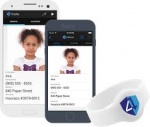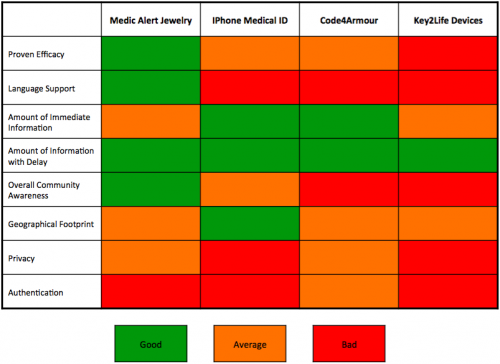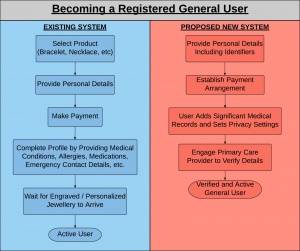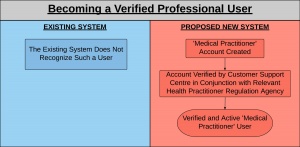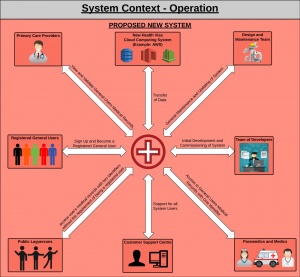Projects:2015s2-211 Health Visa
Contents
TEAM
Group Members
- Samuel Zevenbergen.
- Mingjie Qiu.
Supervisor
Client (Canadian)
BACKGROUND
There are an increasing number of people living with serious allergies, medical conditions and specific treatment wishes without the means of communicating this with First Responders and Paramedics in an emergency situation. There have been many situations where poor outcomes such as avoidable injury or death have resulted from medical treatments administered by medical professionals in emergency situations due to a lack of patient medical history.
The purpose of patient care/healthcare is for medical professionals to use their knowledge and experience as well as all available medical information and advanced directives to make a prompt and competent diagnosis leading to appropriate and correct treatment during a medical emergency. Currently it is in the patient's best interest to ensure they can communicate relevant medical information in case of an emergency. It is also the medical professional's obligation to respond in the correct manner to any medical information and reasonable wishes 07/19/ignoring-a-medic-alert-bracelet 1.
EXISTING SYSTEMS
Currently there are many devices and systems, which can be used by patients to communicate their treatment critical information with medical professionals in the case of emergency where they are unable to.
Despite the current number of options available, there are still cases where speed of access to information, amount and accuracy of information, language barriers, privacy, authentication, security, community awareness and location of the information have resulted in undesirable outcomes such as medical episodes and even death.
In response to this issue, a number of systems have been created, each with weaknesses around the amount of information available, time required to access information, data privacy and/or security. The below sections highlight the pros and cons of each system.
There are a number of systems available for people to communicate their medical details and treatment wishes with first responders. These include: Medic Alert (jewelry), Medical ID (Apple Inc.), Code4Armour and Key2Life systems. Each of these is described below in regard to their efficacy, language support, access requirements, amount of immediate/delayed information, community awareness, geographical footprint as well as privacy and authentication.
Medic Alert
Overview
The Medic Alert Foundation was founded in California in 1953, but now has affiliates in 9 other countries. They are the only non-profit organisation that hires ‘highly skilled medical response personnel’. They offer a range of jewelry (bracelets, anklets and necklaces) with medical information, treatment wishes and ID number engraved on them. To get a medic alert tag, you must purchase the jewelry online, create an online profile, specify details to be engraved and pay an annual subscription fee, which are all dependent on the country you live in. If your medical information changes, you have to purchase a new tag or pay for your current one to be smoothed and re-engraved (which can only be done once or twice).
Pros
- MedicAlert has a proven efficacy.
- Significant language translation service available.
- Good community awareness of the system.
- Significant geographical footprint (9 countries in total).
Cons
- Small amount of immediately available information (only what is engraved on the bracelet).
- There is an extensive delay to obtain further medical information (relayed via phone or fax).
- The system lacks privacy as anyone can access your medical records by reading them off your bracelet.
- There is no authentication required to access the initial information (from your bracelet).
iPhone Medical ID
Overview
Many people have a contact labelled ‘ICE’ - ‘In Case of Emergency’ on their phone, but they have a passcode, which disables anyone from accessing it in an emergency. Apple has developed a medical ID application, which can be enabled on any iPhone with a minimum of iOS-8 installed. This allows anyone to access your medical information such as allergies, blood type and medications as well as your emergency contact details. It also allows them to use your phone to contact your emergency contacts, even if your phone is locked.
Pros
- The amount of information immediately available is significantly greater.
- Exists on a popular phone.
- Significant geographical footprint.
Cons
- There efficacy of this system has not been proven.
- No language translation support.
- Minimal community awareness.
- This system is lacking privacy.
- No authentication required in order to access medical records. No record of someone accessing your records.
Code4Armour
Overview
Code4Armour is a new technology in which you buy and wear a passive bracelet on your wrist. To set this up, you pay an annual subscription fee, create an online account and upload your personal, medical and emergency contact details. Anyone with a Near Field Communication (NFC) capable phone and the free Code4Armour™ app can bring up your details on their phone by scanning your bracelet. There are two types of people (general users and first responders who must be verified).
Pros
- The amount of information immediately available is significantly greater.
- Exists on popular devices.
Cons
- There efficacy of this system has not been proven.
- No language translation support.
- Minimal community awareness.
- There are specific hardware and software requirements in order to access records.
- This system is lacking privacy.
- No authentication required in order to access medical records. No record of someone accessing your records.
Key2Life
Overview
Key2Life is an emerging company offering many medical ID devices, from wearable USB sticks, tags with NFC technology, and cards with magnetic strips and/or QR codes. These systems generally require a once off payment for purchase, with no recurring subscription costs. In a medical crisis where you may be unable to speak for yourself, civilian laypersons and medical physicians can access your information from a computer or a smartphone with NFC/QR reader capabilities. There are some evident hardware and software requirements in order to access the information stored in these devices.
Pros
- The amount of information immediately available is significantly greater.
- Geographical footprint is large, but user base is small.
Cons
- There can be a significant delay in order to access any information (you may need to plug a USB into a computer for example).
- There efficacy of this system has not been proven.
- No language translation support.
- Minimal community awareness.
- There are specific hardware and software requirements in order to access records.
- This system is lacking privacy.
- No authentication required in order to access medical records. No record of someone accessing your records.
Summary of Existing Systems
From the above summaries of current technologies, it should be clear that many of them are relatively complete, but have downfalls. The below figure is a diagrammatic comparison of the already discussed technologies and the completeness of features, which are most important for an efficient system like this. The key point to be made from this diagram is that all current existing systems have major privacy and authentication issues.
HEALTH VISA SYSTEM
System Goals and Objectives
The goal of the Health Visa system is to provide as much information which is relevant
to a user should they find themselves in a medical emergency.
The short term objectives of the Health Visa system are listed below: -
- The system will provide sufficient and relevant medical information, quickly and securely to Medical Professionals and Public Laypersons’ in the event of a medical emergency.
- The system will have a low cost for the end user, facilitating significant growth.
- A positive cost benefit relationship will be apparent to the public.
- The system will be up to date with the relevant and current acts, regulations and standards.
- The empowerment offered to the end-user will be evident as they have full authority and control of their personal information which includes sensitive medical records.
The long term goals of the Health Visa system are listed below: -
- The reach of the system will increase as time goes on. The system is to be implemented in all considered countries within a small timeframe, with further countries expected to be included in the future.
- All members of the public, including young and old will have the available assistance (if required) to become a registered user of the system.
Description of the System
The fundamental objective of the Health Visa system is to overcome the privacy, authentication and security issues associated with all existing medical information systems. The designed system will work across a range of regulatory boundaries, allowing for secure and prompt access to Registered General Users’ medical records during a medical emergency.
It should be noted that the focus of the designed Health Visa system focuses on the back-end security and authentication protocols required to satisfy a range of privacy and data laws around the world, in particular the eight countries listed below.
The Health Visa system will allow for quick access to available medical records during a medical emergency. For example, Paramedics/Medics will have the ability to scan a QR code on a Visa card or bracelet to get access to a Registered General Users’ available medical records. One key aspect to the success of this system is that the user effectively owns their own data, has maximum control over it and thus feels empowered. With this, there will be varying levels of privacy: The user will have the ability to control what information they share with Medical Professionals and Public Laypersons. There will also be a log of who has accessed their information (name, date, location, etc.), which will help discourage abuse and increase accountability for all system users.
There will be three broad classes of system users: Public Laypersons, Registered General Users and Medical Professionals which includes Primary Care Providers, and Paramedics/Medics.
The Health Visa system will allow for different authentication methods (some examples include driver's license, QR code on a visa card and biometrics such as: fingerprint, eye recognition, voice recognition, etc. The Health Visa concept design is not concerned with the authentication methods used, but must allow for a sufficient number of methods, which are continually evolving which are expected to change over time.
Public Laypersons (either Registered General Users or not) will require 2 points of authentication (out of a number of possibilities) in order to access information, whereas Paramedics/Medics only need 1 point. This is because medical professionals generally require information quickly and they are already verified within the system and thus given this privilege.
Language translation is another useful function which is contained within the Health Visa system. In order to facilitate effective communication of information, especially across countries with differing languages, it is necessary to include automatic translation of medical information. An easy and consistent way to implement this language translation function is to use ICD 10 for direct translations of medical terms, thus ensuring the medical records are interpreted correctly and further reducing any risk.
It should be emphasized that the Health Visa system has been designed to be implemented across the eight considered countries initially, with further expansion expected in the future. Language translation is already pertinent to the initial deployment across these eight countries as there are a minimum of three primary languages (English, Estonian and Korean).
Countries of Operation
- Australia.
- United States of America.
- Canada.
- Estonia.
- Israel.
- New Zealand.
- South Korea.
- United Kingdom.


